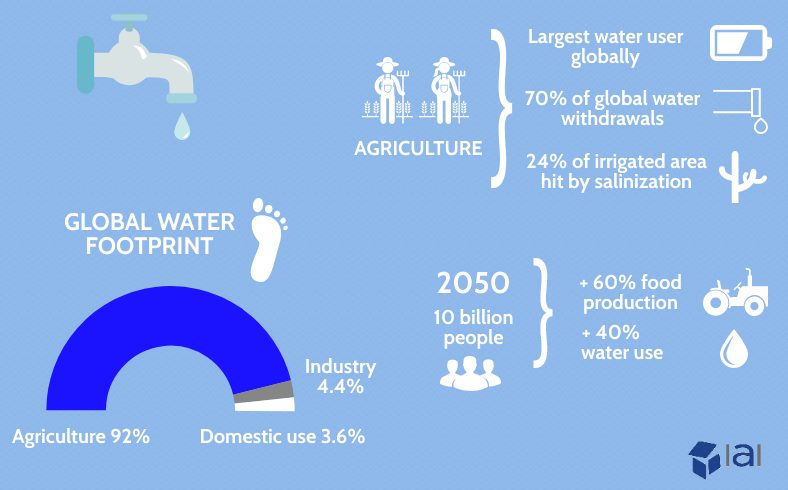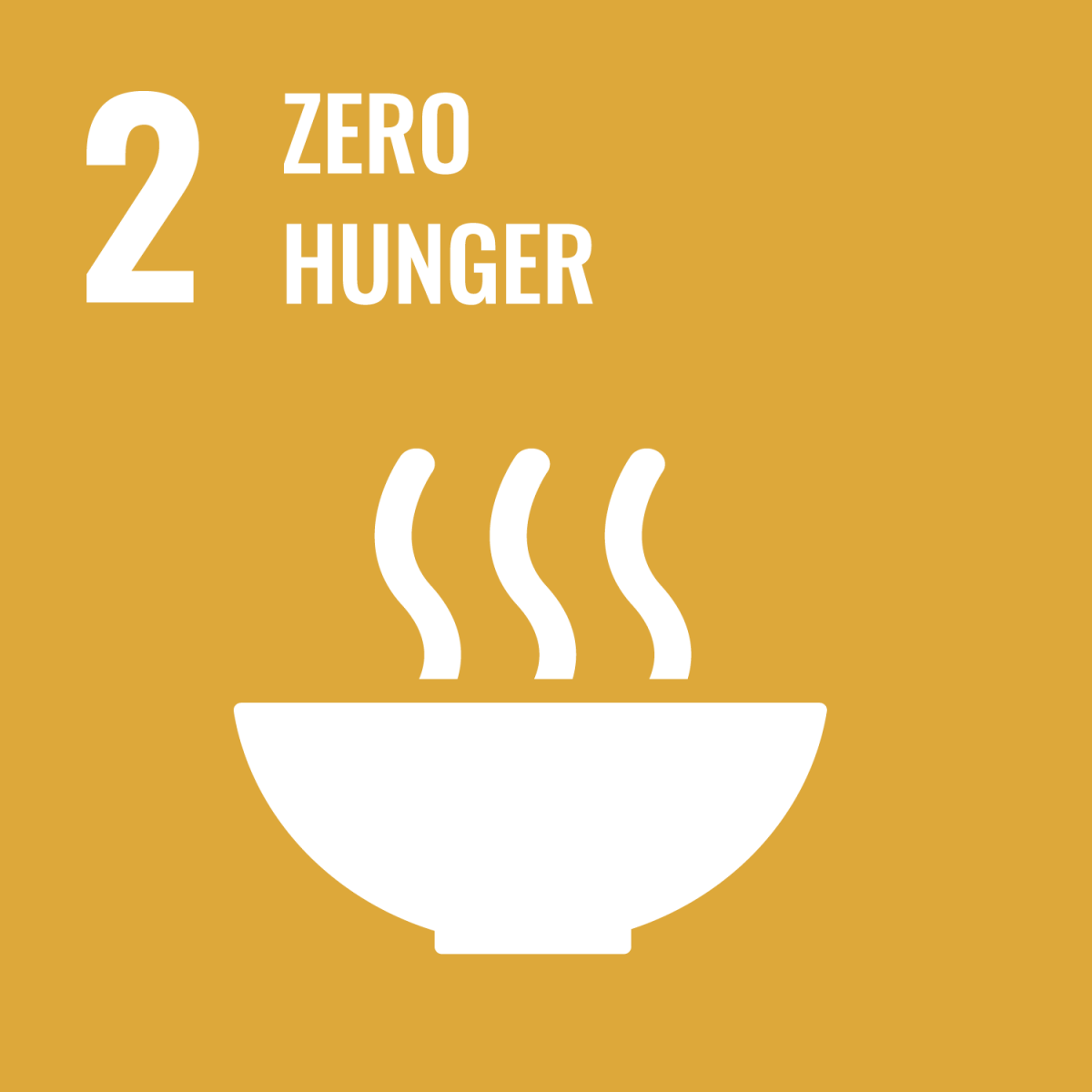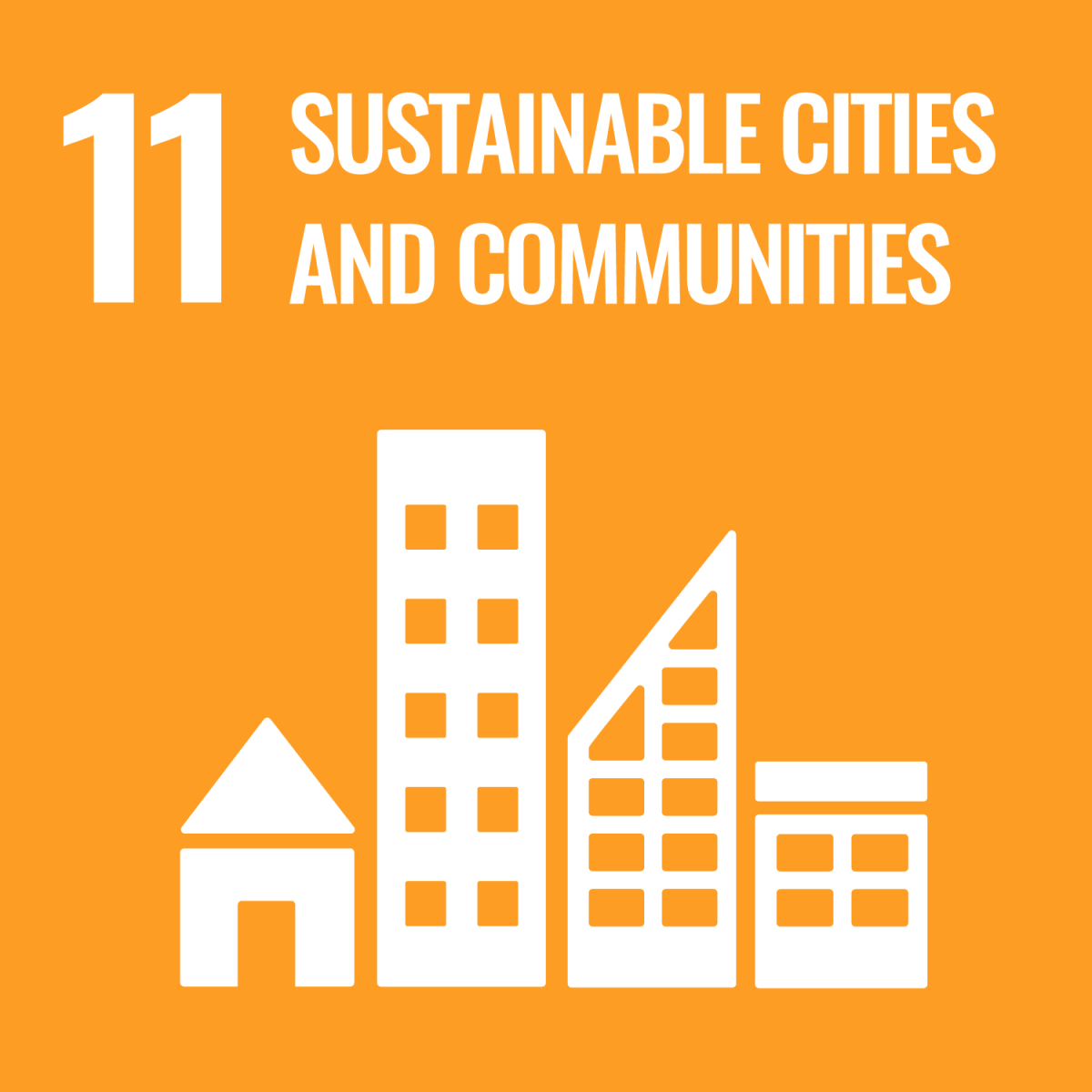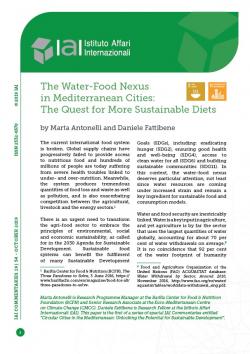The Water-Food Nexus in Mediterranean Cities: The Quest for More Sustainable Diets
The Water-Food Nexus in Mediterranean Cities: The Quest for More Sustainable Diets
Marta Antonelli and Daniele Fattibene*
The current international food system is broken. Global supply chains have progressively failed to provide access to nutritious food and hundreds of millions of people are today suffering from severe health troubles linked to under- and over-nutrition. Meanwhile, the system produces tremendous quantities of food loss and waste as well as pollution, and is also exacerbating competition between the agricultural, livestock and the energy sectors.[1]
There is an urgent need to transform the agri-food sector to embrace the principles of environmental, social and economic sustainability, as called for in the 2030 Agenda for Sustainable Development. Sustainable food systems can benefit the fulfilment of many Sustainable Development Goals (SDGs), including: eradicating hunger (SDG2), ensuring good health and well-being (SDG4), access to clean water for all (SDG6) and building sustainable communities (SDG11). In this context, the water-food nexus deserves particular attention, not least since water resources are coming under increased strain and remain a key ingredient for sustainable food and consumption models.
Water and food security are inextricably linked. Water is a key input in agriculture, and yet agriculture is by far the sector that uses the largest quantities of water globally, accounting for about 70 per cent of water withdrawals on average.[2] It is no coincidence that 92 per cent of the water footprint of humanity relates to agricultural production, with much smaller fractions for industrial (4.4 per cent) and domestic use (3.6 per cent).[3] Moreover, irrigation is the world’s largest producer in volume of wastewater (in the form of agricultural drainage), whereas an estimated 24 per cent of irrigated land worldwide is affected by salinization.[4]
If present demographic and dietary trends continue, food production will need to increase by 60 per cent and agricultural water use by 40 per cent in order to nourish a global population of 10 billion by 2050. This will no doubt exacerbate current water scarcity challenges, which already affect 4 billion people – nearly two-thirds of the world’s population – who experience severe water scarcity for at least one month a year.[5]
Against this backdrop, cities are particularly exposed to water and food-related challenges. Urban centres already suffer from many of these problems, not least since 70 per cent of all produced food is destined for urban settlements and 90 per cent of the inhabitants in urban slums are already food-insecure. The projected percentage of people living in such areas is expected to reach over two thirds of global population by 2050, equivalent to 2.5 billion new residents in urban areas.[6]
Figure 1 | The food-water nexus in figures

These trends are particularly worrying for the Mediterranean, as the region presently boasts one of the highest rates of urban population growth in the world and suffers from severe water scarcity. During the 20th century, the region experienced a fourfold increase of urban dwellers and by 2050, 535 million people are projected to live in Mediterranean cities, equivalent to a 51 per cent increase in less than 40 years if one considered the figure of 350 million from 2015.[7]
The region also faces multiple food related challenges due to population growth, dietary shifts and the impact of climate change. Mediterranean states suffer from the largest water deficit in the world and face a severe ecological deficit as they consume more than twice the amount of natural resources and ecological services than their ecosystems can provide.
Water withdrawals in the Mediterranean region already exceed the critical thresholds of 20 per cent and 40 per cent of total renewable water resources. Agriculture is again the largest sector, accounting for over 85 per cent of total water withdrawals in many Mediterranean countries and where irrigation systems are mainly dependent on groundwater resources. Climate change will further exacerbate these challenges, as two thirds of the region’s economies are predicted to have less than 200 m3 capita/year of water by 2040–2050 (the current European annual average is 3,500 m3, while any amount below 500 m3 is considered as absolute water scarcity).
Almost all Mediterranean countries (except France) depend on imports from foreign countries to meet the food requirements of their populations. Most of them compensate for their lack of water by importing large quantities of virtual water embedded in traded agricultural products and especially food commodities.[8]
The region’s progressively worsening food and water security outlook is placing the Mediterranean diet at risk. The nutritional transition is leading to a progressive shift towards more unhealthy diets, that are causing an increase in obesity rates as well as non-communicable diseases, such as cardiovascular ones.[9] These are dangerous trends, not only because the Mediterranean diet has widely been acknowledged as a model for a safe nutrition, but also because it has proven to be one of the most environmentally sustainable.
The Mediterranean diet is recognized for its major health and nutrition benefits, low environmental impact and richness in biodiversity, high sociocultural food values and positive local economic returns.[10] The combination of “producer-oriented” approaches in agriculture focused on intensive export-oriented production, coupled with the uptake of an increasingly “Westernized diet”, have had important impact on food and nutrition security as well as water stress in the region.[11] These trends are particularly strong in urban settlements and are based on water-intensive foods such as sugar, meat, animal fat, tending to sidestep more nutritious foods such as fruit and vegetables, which are also at the core of a healthy diet.
Recent studies have demonstrated how consuming less meat can lead to significant water footprint reductions, equivalent to 28–53 per cent in big cities.[12] By reducing red meat consumption to internationally recommended levels (less than 100 grams per week),[13] Mediterranean countries could enjoy a more nutritious diet and jointly reduce their water footprint by more than 70 billion m3/year.[14] A better understanding of sustainable consumer patterns will therefore be fundamental to improve consumption models in cities, particularly across the Mediterranean.
Some cities have started to act in this direction, building strong alliances, sharing knowledge and best practices. A notable example is the Milan Urban Food Policy Pact (MUFPP), gathering almost 200 cities all over the world and committed to work jointly to promote more sustainable and healthy food production chains within a human rights-based framework.[15]
Cities will be the place where global trends will pose enormous sustainability challenges, not only with regards to food access, but also considering dietary shifts towards water-intensive diets. Therefore, cities are called to evolve in a sustainable way, making it possible to manage food and water sustainably – financially, socially and politically. They can be the laboratories to promote more sustainable lifestyles where food is put at the core of the political agenda, to ensure not only zero hunger but also many other SDGs, from education to climate action, from public health equality to stable institutions.
Acknowledging the nexus between food and water in cites is essential to launch a transition towards more sustainable societies. Research on environmental sustainability is scarce, however, and policy-makers and stakeholders do not have access to tools that assess the sustainability of current food consumption patterns. The challenge is to develop innovative tools that local governments can use to measure the impact and costs of current development patterns, helping mayors and municipalities adopt policies that allow economic development as well as healthy food and water ecosystems co-exist and re-enforce each other. Mediterranean countries also need to address the nutritional transition and to actively promote education and awareness campaigns on the benefits of the Mediterranean diet, one of the healthiest and most sustainable in the world and one whose preservation may also serve to re-launch cooperation and interdependence between northern and southern shores of the Mediterranean.
* Marta Antonelli is Research Programme Manager at the Barilla Center for Food & Nutrition Foundation (BCFN) and Senior Research Associate at the Euro-Mediterranean Centre on Climate Change (CMCC). Daniele Fattibene is Research Fellow at the Istituto Affari Internazionali (IAI). This paper is the first of a series of special IAI Commentaries entitled “Circular Cities in the Mediterranean: Unlocking the Potential for Sustainable Development”.
[1] Barilla Center for Food & Nutrition (BCFN), The Three Paradoxes to Solve, 3 June 2016, https://www.barillacfn.com/en/magazine/food-for-all/three-paradoxes-to-solve.
[2] Food and Agriculture Organization of the United Nations (FAO) ACQUASTAT database: Water Withdrawal by Sector, Around 2010, November 2016, http://www.fao.org/nr/water/aquastat/tables/worlddata-withdrawal_eng.pdf.
[3] Arjen Y. Hoekstra and Mesfin M. Mekonnen, “The Water Footprint of Humanity”, in PNAS, Vol. 109, No. 9 (28 February 2012), p. 3233, https://doi.org/10.1073/pnas.1109936109.
[4] Javier Mateo-Sagasta, Sara Marjani Zadeh and Hugh Turral (eds), More People, More Food, Worse Water? A Global Review of Water Pollution from Agriculture, Rome/Colombo, FAO/International Water Management Institute (IWMI), 2018, p. 98, http://www.fao.org/policy-support/resources/resources-details/en/c/1144303.
[5] Mesfin M. Mekonnen and Arjen Y. Hoekstra, “Four Billion People Facing Severe Water Scarcity”, in Science Advanced, Vol. 2, No. 2 (12 February 2016), https://doi.org/10.1126/sciadv.1500323.
[6] United Nations, 68% of the World Population Projected to Live in Urban Areas by 2050, Says UN, 16 May 2018, https://www.un.org/development/desa/en/news/population/2018-revision-of-world-urbanization-prospects.html.
[7] Authors’ elaboration from the database of the United Nations Department of Economic and Social Affairs Population Division: World Urbanization Prospects 2018: Data Query, https://population.un.org/wup/DataQuery.
[8] Marta Antonelli and Stefania Tamea, “Food-Water Security and Virtual Water Trade in the Middle East and North Africa”, in International Journal of Water Resources Development, Vol. 31, No. 3 (2015), p. 326-342.
[9] Economist Intelligence Unit (EIU) and BCFN, Fixing Food: The Mediterranean Region, 2017, p. 28, https://www.barillacfn.com/en/publications/fixing-food-the-mediterranean-region-bcfn-foundation.
[10] S. Dernini et al., “Med Diet 4.0: The Mediterranean Diet with Four Sustainable Benefits”, in Public Health Nutrition, Vol. 20, No. 7 (May 2017), p. 1322-1330, https://doi.org/10.1017/S1368980016003177.
[11] Sara Sáez-Almendros et al., “Environmental Footprints of Mediterranean Versus Western Dietary Patterns: Beyond the Health Benefits of the Mediterranean Diet”, in Environmental Health, Vol. 12, Art. 118 (2013), https://doi.org/10.1186/1476-069X-12-118.
[12] D. Vanham et al., “Water Consumption Related to Different Diets in Mediterranean Cities”, in Science of the Total Environment, Vol. 573 (15 December 2016), p. 96-105, https://doi.org/10.1016/j.scitotenv.2016.08.111.
[13] EAT-Lancet Commission, Food Planet Health: Healthy Diets from Sustainable Food Systems. Summary Report of Food in the Anthropocene, 2018, p. 10, https://eatforum.org/?p=4417.
[14] Nahla Hwalla, Rachel A. Bahn and Sibelle El Labban, “Sustainable Food Consumption in Arab Countries”, in Ibrahim Abdel Gelil and Najib Saab (eds), Arab Environment 8. Sustainable Consumption, Beirut, Arab Forum for Environment and Development (AFED), 2015, p. 150, http://www.afedonline.org/Report2015/AFEDreportEng-Ar2015.html.
[15] Yota Nicolarea and Elisa Porreca, “The Milan Urban Food Policy Pact”, in BCFN and MUFPP, Food & Cities: The Role of Cities for Achieving the Sustainable Development Goals, November 2018, https://www.barillacfn.com/en/food-cities.


-
Details
Rome, IAI, October 2019, 5 p. -
In:
-
Issue
19|54



